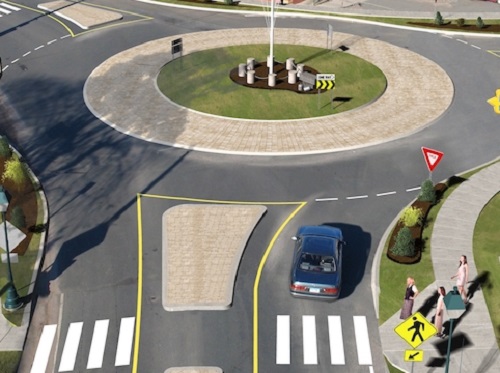The Connecticut Department of Transportation recently implemented new “Complete Streets” design criteria that the agency plans to incorporate into all of its surface roadway projects going forward.
[Above image via the Connecticut DOT]
A “Complete Street” is a roadway planned and designed to consider the safe, convenient access and mobility of roadway users of all ages and abilities. This includes pedestrians, bicyclists, public transportation users, and motorists; it includes children, the elderly, and persons with disabilities.
The agency said this new design criteria expands on its “Complete Street” policy, which ensures that every roadway project includes a focus on pedestrian and bicyclist facilities and public transportation operations to create stronger intermodal transportation networks and improve safety.
The Connecticut DOT’s new ‘Complete Streets’ design criteria focuses on three areas to improve safety and mobility for all roadway users:
- Pedestrian facilities – includes sidewalks, shared use paths, or side paths on both sides of the roadway.
- Bicycle facilities – includes paved outside shoulders, bike lanes, separated bike paths, or shared use paths on both sides of the roadway.
- Transit provisions – includes crosswalks, shelters, benches, and other ways to make existing or proposed transit stops more accessible.
The agency added that if any of its transportation projects does not meet those three criteria, Connecticut DOT’s chief engineer is required to issue a formal design exemption.
“While this change may sound technical, it is a big deal for improving the safety of our transportation network,” noted Garrett Eucalitto, Connecticut DOT’s commissioner, in a statement. “We are doing everything we can to break down barriers to transportation and make Connecticut roadways more accessible for everyone.”
[Editor’s note: In March 2022, the Federal Highway Administration sent a report to Congress detailing the agency’s commitment to “advance widespread implementation” of the “Complete Streets design model” to help improve safety and accessibility for all users. That report – entitled “Moving to a Complete Streets Design Model: A Report to Congress on Opportunities and Challenges” – identifies what FHWA calls “five overarching opportunity areas” that will guide the agency as it moves ahead with efforts to increase “Complete Streets.”]
“Utilizing ‘Complete Streets’ design criteria is just one of the many ways we’re working to make Connecticut safer for all roadway users,” noted Scott Hill, the agency’s chief engineer and bureau chief of engineering and construction.
“This change will solidify and ensure that pedestrian, bicyclist, and motorist safety is incorporated into the billions of dollars’ worth of projects we have planned in our capital program,” he added.
Several state departments of transportation have implemented similar “Complete Street” initiatives over the last several years.
In February 2021, the South Carolina Department of Transportation adopted what it called a “wide-ranging” Complete Streets policy for the state-owned highway system.
That policy requires the South Carolina DOT to work with the state’s regional transportation planning partners and regional transit providers to identify and include walking, bicycling, and transit needs as part of their regional visioning plans.
The California Department of Transportation unveiled a similar “complete streets” policy for all new transportation projects it funds or oversees in December 2021 in order to provide “safe and accessible options” for people walking, biking and taking transit.
Meanwhile, in October 2022, the Kentucky Transportation Cabinet issued a new version of its “Complete Streets” roads and highways manual; a revision that represents the first update in more than 20 years to Kentucky’s pedestrian and bicycle travel policy.
Additionally, in January, Governor Kathy Hochul (D) signed a legislative package allowing the New York State Department of Transportation to provide more fiscal support for municipal ‘Complete Streets’ projects. Under the new legislation, the state’s contribution to the non-federally funded portion of complete street projects will increase to 87.5 percent, which will help municipalities to implement these street designs.

